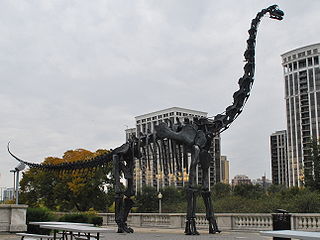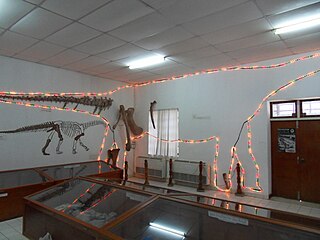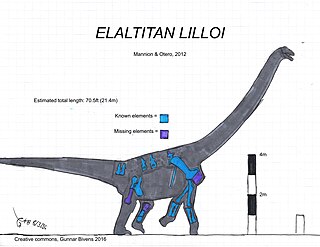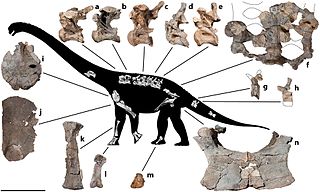
Sauroposeidon is a genus of sauropod dinosaur known from several incomplete specimens including a bone bed and fossilized trackways that have been found in the U.S. states of Oklahoma, Wyoming, and Texas.

The Brachiosauridae are a family or clade of herbivorous, quadrupedal sauropod dinosaurs. Brachiosaurids had long necks that enabled them to access the leaves of tall trees that other sauropods would have been unable to reach. In addition, they possessed thick spoon-shaped teeth which helped them to consume tough plants more efficiently than other sauropods. They have also been characterized by a few unique traits or synapomorphies; dorsal vertebrae with 'rod-like' transverse processes and an ischium with an abbreviated pubic peduncle.

Andesaurus is a genus of basal titanosaurian sauropod dinosaur which existed during the middle of the Cretaceous Period in South America. Like most sauropods, it would have had a small head on the end of a long neck and an equally long tail. Andesaurus was a very large animal, as were many others of its relatives, which included the largest animals ever to walk the Earth.

Huabeisaurus was a genus of dinosaur from the Late Cretaceous. It was a sauropod which lived in what is present-day northern China. The type species, Huabeisaurus allocotus, was first described by Pang Qiqing and Cheng Zhengwu in 2000. Huabeisaurus is known from numerous remains found in the 1990s, which include teeth, partial limbs and vertebrae. Due to its relative completeness, Huabeisaurus represents a significant taxon for understanding sauropod evolution in Asia. Huabeisaurus comes from Kangdailiang and Houyu, Zhaojiagou Town, Tianzhen County, Shanxi province, China. The holotype was found in the unnamed upper member of the Huiquanpu Formation, which is Late Cretaceous (?Cenomanian–?Campanian) in age based on ostracods, charophytes, and fission-track dating.
Gobititan is a genus of herbivorous sauropod dinosaur from the Albian faunal stage of the Early Cretaceous. The name of this genus is derived from the Gobi desert region and the Titans of Greek mythology, which is a reference to its large body size. The specific name shenzhouensis, is derived from "Shenzhou", an ancient name for China.

Tangvayosaurus is a genus of sauropod dinosaur from the Aptian-Albian age Lower Cretaceous Gres superieurs Formation of Savannakhet Province, Laos. It was a basal somphospondylan, about 15 m long, and is known from the remains of two or three individuals.

Phuwiangosaurus is a genus of titanosaur dinosaur from the Early Cretaceous (Valanginian-Hauterivian) Sao Khua Formation of Thailand. The type species, P. sirindhornae, was described by Martin, Buffetaut, and Suteethorn in a 1993 press release and was formally named in 1994. The species was named to honor Princess Maha Chakri Sirindhorn of Thailand, who was interested in the geology and palaeontology of Thailand, while the genus was named after the Phu Wiang area, where the fossil was discovered.

Moabosaurus is a genus of turiasaurian sauropod dinosaur from the Early Cretaceous Cedar Mountain Formation of Utah, United States.

The Cloverly Formation is a geological formation of Early Cretaceous age that is present in parts of Montana, Wyoming, Colorado and Utah in the western United States. It was named for a post office on the eastern side of the Bighorn Basin in Wyoming by N.H. Darton in 1904. The sedimentary rocks of formation were deposited in floodplain environments and contain vertebrate fossils, including a diverse assemblage of dinosaur remains. In 1973, the Cloverly Formation Site was designated as a National Natural Landmark by the National Park Service.
Amargatitanis is a genus of dicraeosaurid sauropod dinosaur from the Barremian-age La Amarga Formation of Neuquén, Argentina.

Lithostrotia is a clade of derived titanosaur sauropods that lived during the Early Cretaceous and Late Cretaceous. The group was defined by Upchurch et al. in 2004 as the most recent common ancestor of Malawisaurus and Saltasaurus and all the descendants of that ancestor. Lithostrotia is derived from the Ancient Greek lithostros, meaning "inlaid with stones", referring to the fact that many known lithostrotians are preserved with osteoderms. However, osteoderms are not a distinguishing feature of the group, as the two noted by Unchurch et al. include caudal vertebrae with strongly concave front faces (procoely), although the farthest vertebrae are not procoelous.

Dongyangosaurus is a genus of titanosaurian sauropod dinosaur from the Late Cretaceous. The only species is Dongyangosaurus sinensis, from which only a single fragmentary skeleton is known, coming from the Zhejiang province of eastern China. It was described and named by Lü Junchang and colleagues. Like other sauropods, Dongyangosaurus would have been a large quadrupedal herbivore.

Xianshanosaurus is a genus of sauropod dinosaur from the Early Cretaceous (Aptian-Albian) of the Ruyang Basin in Henan Province, China. Its type and only species is Xianshanosaurus shijiagouensis. It was described in 2009 by a team of paleontologists led by Lü Junchang. Xianshanosaurus may be a titanosaur, and Daxiatitan may be its closest relative, but its evolutionary relationships remain controversial.
Liubangosaurus is a genus of sauropod dinosaur that lived during the Early Cretaceous in what is now China. The type and only species is Liubangosaurus hei, first described by Mo Jinyou, Xu Xing and Eric Buffetaut in 2010. Liubangosaurus is known from the holotype NHMG8152, five nearly complete and articulated middle-caudal dorsal vertebrae that were collected from the Xinlong Formation in Fusui County, Guangxi Province. Jinyou et al. (2010) found that Liubangosaurus belonged to the clade Eusauropoda.

Elaltitan is an extinct genus of large lithostrotian titanosaur sauropod dinosaur known from the Late Cretaceous of Chubut Province, southern Argentina. It contains a single species, Elaltitan lilloi.
Paluxysuchus is an extinct genus of neosuchian crocodyliform known from the Early Cretaceous Twin Mountains Formation of north-central Texas. It contains a single species, Paluxysuchus newmani. Paluxysuchus is one of three crocodyliforms known from the Early Cretaceous of Texas, the others being Pachycheilosuchus and an unnamed species referred to as the "Glen Rose Form". Paluxysuchus has a long, flat skull that is probably transitional between the long and narrow skulls of many early neosuchians and the short and flat skulls of later neosuchians.

Padillasaurus is an extinct genus of titanosauriform sauropod known from the Early Cretaceous Paja Formation in Colombia. It contains a single species, Padillasaurus leivaensis, known only from a single partial axial skeleton. Initially described as a brachiosaurid, it was considered to be the first South American brachiosaurid ever discovered and named. Before its discovery, the only known brachiosaurid material on the continent was very fragmentary and from the Jurassic period. However, a more recent study finds it to be a basal somphospondylan.

Savannasaurus is a genus of titanosaurian sauropod dinosaur from the Late Cretaceous Winton Formation of Queensland, Australia. It contains one species, Savannasaurus elliottorum, named in 2016 by Stephen Poropat and colleagues. The holotype and only known specimen, originally nicknamed "Wade", is the most complete specimen of an Australian sauropod, and is held at the Australian Age of Dinosaurs museum. Dinosaurs known from contemporary rocks include its close relative Diamantinasaurus and the theropod Australovenator; associated teeth suggest that Australovenator may have fed on the holotype specimen.
Triunfosaurus is a genus of somphospondylan sauropod dinosaur from the Early Cretaceous of Brazil. It contains a single species, T. leonardii, described by Carvalho et al. in 2017. As a genus, Triunfosaurus can be distinguished from all other titanosaurs by the unique proportions of its ischium. It was initially described as a basal titanosaur, making it the earliest basal titanosaur known; however, subsequent research questioned the identification of the taxon as a titanosaur, instead reassigning it to the Somphospondyli.

Mierasaurus is an extinct genus of sauropod dinosaur from the Early Cretaceous of Utah, United States. The taxon was first described and named in 2017 by Rafael Royo-Torres and colleagues, from a mostly complete skeleton including a disarticulated partial skull and mandible, teeth, multiple vertebrae from along the length of the body, both scapulae, radius and ulna bones, a left manus, a complete pelvis, both femora and the entire left hindlimb. Additionally, they referred a lower jaw and femur from juvenile individuals, which were found nearby, to the genus. Collectively, Mierasaurus is among the most completely known North American sauropods. The genus name honours Bernardo de Miera y Pacheco, the first European scientist to enter what is now Utah. The type species for Mierasaurus is Mierasaurus bobyoungi, named after Robert Glen Young, a paleontologist who researched the Early Cretaceous of Utah.

























